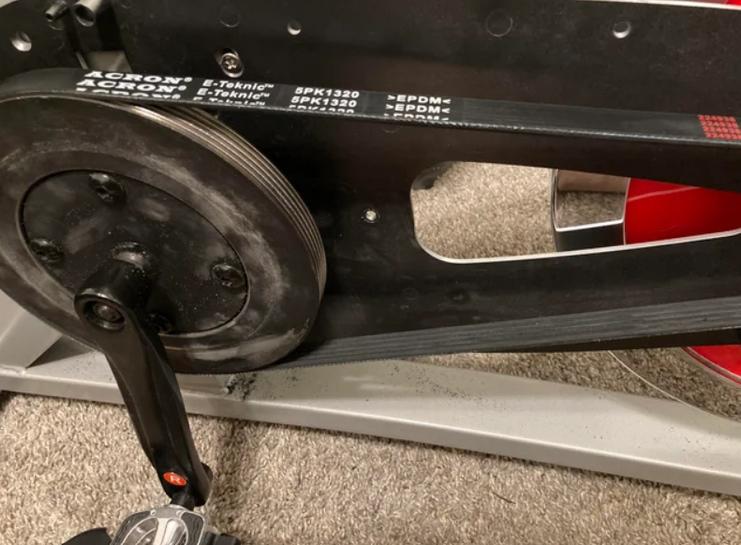Understanding the Importance of the Replacement Belt for Your Upright Bike
Upright bikes are a staple in home gyms and fitness centers alike, offering a convenient way to achieve cardiovascular fitness. At the heart of these machines is the drive belt, a vital component that ensures the smooth operation of the bike. Without a properly functioning belt, the performance and efficiency of the bike can be severely compromised. Understanding the significance of the replacement belt is crucial for maintaining the longevity and functionality of your upright bike.
A replacement belt is not merely a piece of rubber; it is the linchpin that connects the pedal movement to the flywheel, ensuring a seamless riding experience. Over time, belts can wear out due to friction, tension, and environmental factors, which can lead to decreased performance or even complete mechanical failure. Therefore, regular inspections and timely replacements are essential for keeping your bike in top condition.
Moreover, the correct belt not only enhances performance but also contributes to the safety of the user. A worn-out belt can slip or break, potentially leading to accidents or injuries during use. Thus, understanding the importance of selecting the right replacement belt is paramount for anyone looking to ensure both a safe and effective workout experience.
Signs That Your Upright Bike Needs a Replacement Belt
Identifying when your upright bike requires a new belt is crucial to avoid unexpected breakdowns and ensure continuous use. One of the most common indicators is a noticeable reduction in the bike's performance. If the bike feels less smooth or if the resistance levels are inconsistent, it might be time to inspect the belt for wear and tear.
Another clear sign is the presence of unusual noises. Squeaking, grinding, or clunking sounds during operation can suggest that the belt is slipping or has become misaligned. These sounds are often a precursor to more significant issues, and addressing them early can prevent further damage to the bike's components.
Physical inspection of the belt can also reveal the need for replacement. Look for visible signs of wear such as cracks, fraying, or thinning. If the belt appears stretched or loose, it's likely no longer providing the necessary tension to operate the bike efficiently. Regular checks can help in spotting these signs early and scheduling a timely replacement.
Factors to Consider When Choosing a Replacement Belt
Selecting the right replacement belt involves several key considerations to ensure compatibility and performance. First and foremost, it's essential to know the make and model of your upright bike. Different bikes have specific belt requirements, and using the wrong one can lead to poor performance or damage.
Material is another critical factor. Replacement belts can be made from various materials such as rubber, polyurethane, or even Kevlar for enhanced durability. Each material has its own set of benefits and drawbacks, with rubber being the most common due to its flexibility and cost-effectiveness. However, if you seek a more durable option, polyurethane or Kevlar belts might be preferable.
Lastly, consider the belt's tension and size. The belt must fit snugly to ensure proper operation, and the tension should be adjustable to accommodate wear over time. Consulting the bike's manual or a professional can provide guidance on the correct specifications for your replacement belt, ensuring optimal performance and longevity.
Types of Replacement Belts for Upright Bikes
Replacement belts for upright bikes come in various types, each with specific features designed to meet different needs. Understanding these types can help you make an informed choice that best suits your bike and workout regimen.
-
V-Belts: These are among the most common types used in upright bikes. They are known for their efficient power transmission and ability to handle high-tension operations. V-belts have a trapezoidal cross-section that provides a tight grip on pulleys, ensuring minimal slippage.
-
Poly-V Belts: Unlike traditional V-belts, Poly-V belts have multiple ribs running along their length. This design increases surface contact with the pulleys, offering superior power transmission and reduced noise levels. They are ideal for high-performance bikes that require smooth and quiet operation.
-
Timing Belts: These belts have teeth that match grooves in the pulleys, providing precise synchronization between the pedal and the flywheel. Timing belts are often used in high-end models where precision is critical for performance. They are resistant to slippage, making them a reliable choice for consistent workouts.
Choosing the right type depends on your specific bike model and personal preferences. Consulting the bike’s manual or a fitness equipment specialist can provide additional insights into which type of belt is most suitable for your needs.
How to Measure Your Upright Bike for the Right Replacement Belt
Accurate measurement is key to ensuring you select a belt that fits perfectly. A poorly fitting belt can lead to slippage, inefficiencies, and potential damage to your bike. Here’s a step-by-step guide to help you measure your upright bike for a replacement belt:
-
Remove the Old Belt: Carefully detach the current belt from the bike, ensuring you note its path and how it was installed. This will be useful when fitting the new belt.
-
Measure the Length: With the old belt laid flat, use a tape measure to determine its length from end to end. If the belt is broken, measure both pieces and add the lengths together.
-
Determine the Width: While the belt is on a flat surface, measure its width. This will help ensure the new belt fits snugly into the pulleys.
-
Check the Profile: Identify the belt’s profile, whether it’s a V-belt, Poly-V, or another type. This can often be determined by the cross-section shape of the belt.
By following these steps, you can ensure you purchase a belt that fits your upright bike perfectly, enhancing its performance and longevity.
Top Brands for Replacement Belts
When it comes to quality and reliability, choosing a reputable brand for your replacement belt can make a significant difference. Here are some top brands known for their excellence in producing high-quality belts for upright bikes:
-
Schwinn: A well-known name in the fitness industry, Schwinn offers a range of durable and reliable belts designed for various models of upright bikes. Their products are known for their longevity and performance.
-
Proform: As a leader in home fitness equipment, Proform provides belts that are specifically designed to fit their machines. They offer a variety of belts, ensuring that users find the perfect match for their specific bike model.
-
Sunny Health & Fitness: This brand is renowned for its affordable fitness equipment and accessories. They offer a selection of replacement belts that combine quality with affordability, catering to a wide range of bike models.
Each of these brands offers a variety of options to suit different needs, ensuring that you find a belt that not only fits your bike but also meets your performance expectations.
Installation Tips for Your New Replacement Belt
Installing a new replacement belt on your upright bike may seem daunting, but with the right approach, it can be a straightforward process. Here are some tips to guide you through the installation:
-
Refer to the Manual: Always start by consulting the bike’s manual for specific instructions related to belt replacement. This ensures you follow the manufacturer’s recommended procedures.
-
Prepare the Bike: Before handling the new belt, ensure the bike is stable and securely positioned. Remove any covers or guards that may obstruct access to the belt path.
-
Align the Belt Properly: Carefully route the new belt along the same path as the old one. Ensure it is correctly seated on all pulleys and that there are no twists or kinks.
-
Adjust the Tension: Once the belt is in place, adjust the tension according to the specifications in the manual. The belt should be taut but not overly tight, providing smooth operation without slippage.
Following these steps will help ensure a successful installation, allowing you to enjoy your upright bike’s improved performance.
Maintenance Tips for Prolonging the Life of Your Replacement Belt
Proper maintenance is key to extending the life of your replacement belt and ensuring your upright bike operates smoothly. Here are some tips to keep your belt in top condition:
-
Regular Inspections: Frequently check the belt for signs of wear, such as cracks, fraying, or stretching. Addressing these issues early can prevent more significant problems down the line.
-
Keep It Clean: Dust and debris can accumulate on the belt and pulleys, leading to premature wear. Use a soft cloth to wipe down the belt and surrounding components regularly.
-
Avoid Over-Tensioning: While it’s important to maintain proper tension, over-tightening the belt can lead to stress and damage. Follow the manufacturer’s guidelines for the correct tension levels.
By incorporating these maintenance practices into your routine, you can enhance the longevity and performance of your replacement belt, ensuring a smooth and efficient workout experience.
Troubleshooting Common Issues with Replacement Belts
Even with the best maintenance practices, issues with replacement belts can arise. Being able to troubleshoot these problems can save time and prevent further damage to your upright bike.
-
Slipping Belt: If the belt slips during use, it may be due to incorrect tension or misalignment. Check the tension and adjust it as needed. Ensure the belt is properly aligned on all pulleys.
-
Unusual Noises: Squeaking or grinding sounds can indicate misalignment or debris caught in the pulleys. Inspect the belt path and clean any debris. Realign the belt if necessary.
-
Uneven Resistance: If the bike's resistance feels uneven, it could be a sign of wear or damage to the belt. Inspect the belt for any visible damage and replace it if necessary.
Addressing these issues promptly can help maintain the performance of your upright bike and extend the life of your replacement belt.
Conclusion: Ensuring a Smooth Ride with the Right Replacement Belt
Choosing the right replacement belt for your upright bike is crucial for maintaining its performance and ensuring a safe workout experience. By understanding the importance of the belt, recognizing when it needs replacing, and selecting the appropriate type, you can enhance the durability and functionality of your bike. Proper installation and regular maintenance further contribute to the belt’s longevity, ensuring you enjoy a smooth and effective ride every time.
For those looking to extend the life of their fitness equipment, investing in a high-quality replacement belt is a wise decision. With the information provided in this guide, you can confidently choose the right belt that meets your needs and enhances your workout experience.


